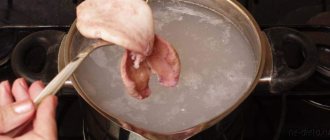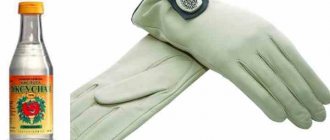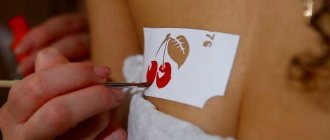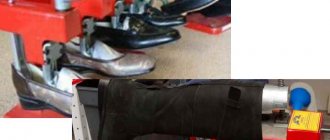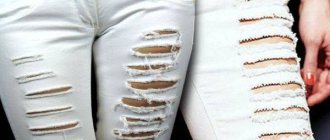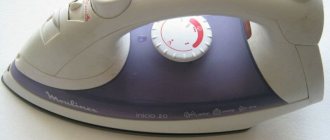Preparation for the procedure and rules for its implementation
For ironing you will need an iron (preferably with a steam function) and a damp cloth. The device must be heated to the required temperature (it must be indicated on the tag of the item of clothing).
All folds and creases must first be removed.
You need to remove all unnecessary items from your pockets.
Now you can find out how to iron a jacket correctly, that is, in what order it is best to do it:
- First, the product is turned inside out and laid out on a horizontal surface. The lining needs to be spread out as much as possible. After this, the pockets are smoothed until the intervening tissue is completely dry.
- Next, the sleeves are processed. For convenience, you can use a special stand on which this part of the product is placed. Do not allow wrinkles to appear on the elbow. Instead of a stand, you can use a tightly rolled towel.
- Now let's move on to the shoulders. Here you will need a steaming function.
- Next, the edges, shelves and back are ironed. These parts of the jacket are processed on both sides. It is imperative to use a damp intermediate cloth.
- Lastly, the collar and lapels are ironed. They are processed without steaming through a damp cloth. This should be done only from the wrong side of the product. If these parts are too wrinkled, then in this case you need to iron the jacket after pre-wetting it with a little pulling and pressing. The corners need to be worked well with the tip of the iron.
A damp cloth is necessary for ironing so that the fabric on the jacket does not become shiny and there are no streaks on it. The gauze should be moistened in clean, preferably distilled water.
How to iron a jacket
Ironing hangers is not much different from straightening fabric on sleeves. The main thing is to pay attention to the seams. The best option would be to use a steamer. Then you can hang the jacket on a hanger and gently pass through the hot steam. After drying a little, the clothes are ready to complement your look.
If you do not own such equipment, then:
- Hang the jacket on a hanger and straighten it by hand.
- Raise the iron with the steam setting set to 20 centimeters.
- Steam the material thoroughly, slightly stretching the product with your hands. Afterwards, dry the jacket thoroughly without removing it from the hanger.
If the model does not have special foam hangers, then you can iron the material on a flat surface. Follow these instructions:
- Carefully place a hanger on the edge of the board and straighten the material.
- For ironing, use only the tip of the iron.
- From the wrong side, go through all the seams and corners of this section of the jacket.
- It is recommended to take the hangers after the back and sides of the clothing.
So, the ironing process can be divided into the following stages:
- Turn the items inside out and check the contents of the pockets. Take all of them out, carefully straighten and iron the pockets on both sides;
- Sleeves. They are also ironed from the inside out. Placed on a special platform. The sleeves begin to be ironed at maximum temperature, turning along the axis. It is advisable to cover the sleeves with gauze to protect the existing fittings. Particular attention should be paid to the area around the seams;
- Shelves, edges, back. Ironed both from the inside and from the front side. A gauze lining is required to protect the material. Buttons and other metal fittings do not need to be ironed.
- Collar, lapels. These areas are viewed from the front. Lightly moistened gauze is placed on top of the fabric. You can additionally spray water from an iron or spray bottle. Hard-to-reach places and corners are smoothed with a spout using steam.
When ironing a jacket, it is necessary not only to follow a certain sequence. It is also important to take into account such factors as the material from which the jacket is made. Depending on this, a certain temperature and ironing mode is selected.
How to iron a linen jacket.
Linen jackets were very popular in the 30s of the last century. Linen is a very pleasant and practical fabric that is ideal for wearing in hot weather. Such knitted products have good breathability, quickly absorb moisture, and do not stick to the body. These outfits are ideal for men and women who want to look respectable and at the same time comfortable, even in the hottest heat.
As a rule, such jackets are worn with a slight wrinkle. Linen fabrics should only be ironed while damp, from the inside out.
Remember that you cannot iron a linen jacket perfectly; you can only remove strong folds and creases. Unless absolutely necessary, it is better not to start this process at all.
Where is it better to steam a jacket: at home or at the dry cleaner?
Dry cleaning services are relatively inexpensive and can be very useful for a person with limited home space or time pressure.
For parents of several schoolchildren, it may be much more profitable to turn to specialists, just like a man or woman who has a lot of such wardrobe items. When financial conditions allow you to take things to the dry cleaner regularly without experiencing inconvenience, then this is an excellent solution . In a special institution, processing is carried out at a high level, using technology. In cases where this is not possible, there is no need to be upset - after about your third home steaming, you will get the result no worse.
What to wear with a blue jacket: men's, women's
What is a leather jacket
Features of ironing jackets, depending on the type of fabric
Many types of fabric are used to sew jackets. Everyone has a completely logical question: how to iron a jacket made of a particular material without ruining it? The answer is simple: choose the temperature carefully.
Cotton
The most unpretentious type of fabric. Products made from this natural fiber withstand high temperatures very well. To make ironing a cotton jacket easier, you should use a spray bottle. After the product has been ironed with a damp cloth, you can go through it again using dry cloth for lining. This simple action will remove excess moisture from the surface of the clothing and fix the result.
Linen
Linen products are quite difficult to iron 100% efficiently. These jackets usually do not have a synthetic lining, so you can process the inside first, then the outside. A good supply of steam to the surface of the fabric will facilitate the process.
Velveteen
This noble material does not like to be ironed against the grain. Therefore, the iron should be directed only in the direction of the pile, otherwise you can easily bend the pile, ruining the appearance of the jacket. The temperature should be low, thick gauze is required.
Wool
A wool jacket is as susceptible to high temperatures as it is to hot water. Such a product should be carefully ironed with steam at a minimum temperature through a double layer of gauze. Careful care will not only allow you to look your best, but also extend the life of your favorite item.
Leather
Typically, leather items do not wrinkle. This can happen if the jacket has been folded for a long time. If it is of high quality, made of genuine leather, then you can use an iron with a minimum temperature and iron it through a dry cloth. If nothing bad happened at the first touch of the iron, then the jacket is really leather and the manufacturer is honest.
Synthetics
In this case, the steam will not give much effect, therefore, it can be turned off and the temperature reduced to the minimum. Jackets made of synthetic fabrics can be safely ironed first from the inside and then from the front side. This way the best result will be achieved.
Other fleecy fabrics, including artificial ones
Velvet jackets, as well as those made of unnatural fleecy fabric, are best ironed in the direction of the pile - from top to bottom. In order not to spoil the pile, be sure to use gauze or ironing cloth.
What you absolutely cannot do
- The jacket should not be put on or put in the closet immediately after ironing. Let it cool first and take its final shape.
- Store the product on hangers, and it would be correct to place it in a special storage case;
- Fabric with long pile is never ironed on the front side;
- To prevent the surface of the material from becoming shiny, the gauze should not be laid in a very wet state;
- Never hold the iron in one place for more than 5 seconds. Remember, the thinner the material, the faster and more carefully you need to iron.
We hope our tips will help you properly iron your jacket at home. To prevent the product from becoming too wrinkled, wash it only by hand or on a delicate cycle in the machine. Do not spin at high speeds or twist the fabric. Allow the item to dry horizontally, and excess moisture can be removed by soaking it with a towel. Take care of things right!
Useful tips for ironing a jacket.
If the jacket is made of smooth material, then start the ironing process from the bottom up. If the knitwear has a small pile, then on the contrary, start from the top. This is done so that the pile lies flat, without any creases.
Once you have chosen the direction for ironing the suit fabric, follow it along the entire perimeter.
Don't forget to wring out the gauze after you've wet it, otherwise you may end up with shiny patches on your jacket.
When the jacket is very wrinkled and you can’t iron it using standard means, and you don’t have a steam generator, then pour boiling water into a basin and hang the suit over it. After 10 minutes you can start ironing it, usually after such heat treatment, all the creases that you previously could not give in to are smoothed out well.
If you see a shiny sheen on the surface of the jacket, then iron this area, placing a damp woolen cloth on top. You can also try cleaning the area using a melamine sponge.
On some jackets you can find buttons made of metal or other similar materials, be careful with them, they are easily heated by the iron and can melt the fabric around them. There are jackets that are based on synthetic fabrics; they require attention; they must be ironed using a minimum temperature regime, without a steam generator.
Jackets made of different materials: ironing features
In addition to the standard rules, there are a number of additional recommendations from classic suiting manufacturers regarding how to iron a particular fabric.
Wool jacket
The peculiarity of wool clothing is that it can stretch or shrink. Therefore, to avoid stretching the seams and material, the iron cannot be carried over the parts. Apply the device first to one place and then to another. At the beginning of the ironing procedure, the product should be slightly damp - and at the end - almost dry.
Corduroy jacket
It is necessary to iron a jacket made of pile fabric with special attention so that it does not lose its appearance. A corduroy jacket should be ironed only in the direction of the pile and from the inside out
Place the front part of the product not on a board, but on a piece of fleecy fabric or a towel.
Follow these guidelines when straightening corduroy fabrics:
- Do not handle the product dry.
- Do not iron your jacket while it is wet.
- To avoid stains, do not spray water on the front of the product.
- For the ironing procedure, use a device with a Teflon sole and a steamer.
- Iron only from the inside out.
- Do not press the iron too hard to avoid deforming the pattern of the material.
Linen jacket
Since a linen jacket does not have a lining, this will facilitate the difficult process of straightening out folds and creases on it. In addition, if a linen jacket is a little wrinkled and does not look perfect, then you should remember that slight wrinkles are the norm for such products.
How to iron a leather jacket?
Leather products often become wrinkled after being stored in closets for a long time and lose their respectable appearance. If you doubt your abilities or don’t know how to choose the appropriate method for ironing a leather product, then use dry cleaning services
We suggest you familiarize yourself with several methods for ironing leather items at home, however, you need to resort to these tips very carefully, since leather, both natural and artificial, is a very delicate material. If you do the ironing process incorrectly, you can ruin it.
We hope that thanks to our article, you ironed your jacket correctly, you have no more questions, and your product shines with cleanliness and beautiful appearance.
- Cotton and linen. The use of high temperatures is acceptable. In addition to using a damp iron, it is advisable to wet the product itself to obtain a better result. It is quite difficult to completely iron out linen items, so slight wrinkles are acceptable.
- Polyester and other synthetics. Products are ironed with a warm iron without steaming. It is not effective in this case due to the poor absorbent properties of synthetics.
- Wool and corduroy, fleecy fabrics, with relief patterns. The use of additional damp cloth is mandatory. The iron is used using pressing movements rather than sliding ones.
- Silk. Natural fabrics should not be ironed at all. Synthetic types of silk are ironed at the lowest temperatures without spraying, as it leaves stains. Steam at a distance is a favorable way to process silks.
Steaming
If the iron is powerful enough and the vertical steaming function does not cause any complaints, caring for the jacket comes down to steam treatment.
- The product is placed on a hanger or a special rack, cleaned of dust and straightened.
- Special inserts or tightly rolled cotton towels are placed in the sleeves.
- The jacket is treated with a jet of steam at a distance recommended by the instructions, from top to bottom if it is made of fleecy fabric, and from bottom to top when it is made of smooth fabric.
How to iron a jacket without an iron?
Steam generator
Steam generators are a real find. They facilitate the ironing process, make it better and faster. Under the steam jet of this device, any, even the most harmful, wrinkle or crease can be easily smoothed out. But the main disadvantage is the high price and not everyone can afford it. What to do if the jacket is very wrinkled, and, as luck would have it, you don’t have an iron at hand?
High humidity
You need to hang the dry item on hangers and place it above the bathtub. It is better to clean the jacket well before ironing to avoid stubborn stains. Then turn on the hot (very hot) water and fill the bathtub, closing the door. Folds exposed to hot steam will become soaked in 15-25 minutes. Then you just need to dry the item or, if the creases are strong, put it under a press, straightening out the problem areas as much as possible. A stack of thick books can serve as a press.
Vinegar
Another great way is to mix water, fabric softener and 6-9% vinegar in a spray bottle. Spray the jacket and shake it well. Then you should leave the jacket hanging for an hour or two, so that under the influence of its own weight, the fabric straightens. We invite you to watch a video that offers several more alternative ironing methods.
You will learn about several more methods from the video:
https://youtube.com/watch?v=czqT1-hhsow
Most people who have jackets made of various materials in their wardrobe do not have a clear idea of how to care for a jacket, wash and iron it. For a good result, you just need to be able to read the label sewn on the inside, maintain the correct temperature conditions and use damp gauze. Also, do not forget to follow the tips that were described in the article. Then the process will not take a lot of nerves, time and money.
How to iron
The most important thing is to follow a certain sequence. If you follow the rules, you can end up with an ideal item that will have a neat and tidy appearance.
The sequence of the ironing process is as follows:
Pockets. It is with this element that you need to start - turn it inside out, smooth out all the folds and begin ironing it through damp gauze. Sleeves and shoulders. This stage is considered the most time-consuming and difficult
Particular attention should be paid to the sleeves. At the moment, special attachments for ironing these elements are sold.
They are worth using. This will help iron the jacket without marks or unevenness. Sleeves and shoulders should be ironed from the wrong side. Shelves, back and sides. These parts are easy to iron. But there is a small nuance. If at the previous stages ironing took place from the wrong side, then these elements are processed from the front.
Lapels and collar. These are the smallest details, but you shouldn’t pay less attention to them. A wrinkled collar and poorly smoothed lapel can ruin the appearance of your clothes. These parts are ironed from the front side, having first moistened them well. It is very convenient to straighten the corners using the sharp nose of the iron.
How to iron pockets correctly
To iron a pocket well, you should first turn it inside out and smooth it out. Only after this can you proceed directly to the ironing process itself, not forgetting to use a well-moistened cotton cloth as an auxiliary element. After the pockets are ironed, they must be turned back out very carefully.
Important! Ironing pockets should be done from the wrong side
How to iron sleeves and shoulders
As practice shows, these elements are the most difficult to iron well, so you need to be patient and have plenty of time.
Ironing these parts is called the most labor-intensive process. To cope with the task well, you need to properly moisten them and smooth out all the folds, then iron until all the moisture has evaporated from the surface of the fabric. In addition, do not forget that the procedure should be carried out from the inside out and using gauze.
Particular attention is paid to the sleeves. It would be a good idea to visit a hardware store and purchase a special attachment.
Modern manufacturers add it to any ironing board, but you can also purchase it separately. If the nozzle is not at hand, then you can use rolled towels, which will need to be placed inside these elements of the product.
Don't forget about the hangers too. In order to iron them well, there are also special stands
In this element, special attention should be paid to the elbow and shoulder seams. Before you start ironing, they must be carefully leveled and free from wrinkles.
How to iron the edges, back and shelves
It is important to note that you need to use a certain amount of cotton fabric as an auxiliary tool. Gauze is ideal
The back, hems and shelves are considered the simplest elements to iron. It is enough to level the material, take moistened gauze and begin processing the fabric. Experienced housewives recommend not pressing too hard on the fabric, otherwise angular marks from the iron may remain on it, which will not have a very good effect on the appearance of the product.
Important! To avoid the appearance of shiny marks on the fabric, it is necessary to regularly moisten the gauze or auxiliary material so that they do not have time to dry out. Working with shelves, back and hem is not difficult, but the slightest mistake can lead to glossy marks forming on the fabric, which will be extremely difficult to get rid of
Working with shelves, back and hem is not difficult, but the slightest mistake can lead to glossy marks forming on the fabric, which will be extremely difficult to get rid of.
The final stage is the collar and lapels
Despite the fact that these details in the jacket are the smallest, their importance cannot be underestimated. Despite the fact that the collar and lapels cannot be called large, any fold or wrinkle on them will instantly catch your eye. And this will greatly spoil the overall impression of the jacket, introducing disharmony.
The collar and lapels should be ironed from the front side using a heavily moistened cloth or gauze. Before you begin the process, you should carefully level the part on the ironing board so that there are no unevenness or small folds.
Important! If the folds on the lapel or collar are too strong, you need to moisten them with water.
Step by step description
To iron a piece of a suit correctly and avoid the formation of creases, you need to do the work in a certain order.
- Ironing pockets. They will need to be turned out and ironed through a damp cloth, and then returned to their place and ironed once tucked in.
- Steam treatment of sleeves and shoulder seams. This part of the work is considered the most difficult, since such items of clothing can only be put in order using a special iron or a rolled towel. They are inserted into the sleeves or placed under the “shoulders”, after which the desired areas are smoothed through damp gauze.
- Ironing of hems, front and back. First, these parts are ironed from the wrong side, and then turned inside out and re-steamed using a damp cloth.
- Lapels and collar. These areas are ironed only from the front side, slightly stretching the material and straightening the corners of the parts with the “nose” of the iron.
There are many videos published on the Internet about how to iron a jacket at home. We will tell you about the proven and most popular method below:
- Place the board in a position that is comfortable for you. Turn on the iron and pour distilled water into the bowl.
- Moisten the gauze, squeeze thoroughly, it is recommended to shake several times. As the fabric dries, re-wet it.
- Before you start ironing the suit part, set the lighting to the correct level. It should fall from the left.
- The process begins with the sleeves, so stretch the fabric over the additional special compartment. Place slightly damp gauze on top. Iron the material, slowly moving from the edges of the jacket to the shoulders. Straighten the fabric so that there are no wrinkles. When one side of the sleeve is ironed, carefully turn it to the opposite side and repeat.
- Next, pull both shoulders of the jacket one by one onto the edge of the board and go through it thoroughly with an iron. Afterwards the side and back are ironed. Finally, you need to pay attention to the collar, manually straightening it in advance.
The ironed item is hung on hangers and placed in the closet so that it does not touch the rest of the clothes. It is recommended to put on the cover first.
Additional Tips
To achieve the unchanged shape of things after ironing, you can create all possible favorable conditions for this:
- Steaming is preferable for jackets rather than direct ironing. It is not necessary to use classic steam generators; you can hang your jacket in the bathroom with hot water in it.
- After ironing, it is not recommended to immediately put the item away in the wardrobe or put it on for wear. You need to allow the product to completely cool and dry. Such actions will help preserve the shape and consolidate the ironing result.
- A jacket with metal buttons needs to be ironed more carefully. After all, there is a risk of damage to the soleplate of the iron and the buttons becoming dull.
By following the proposed rules and recommendations, the ideal condition for the item is ensured. Whether to iron a jacket or use steaming – in each individual case the housewife makes her own decision. In any case, the effect will be no worse than from chemical cleaning.
Another great article: How to wash eco-leather.
It is worth noting that you should initially read the recommendations from the manufacturer, which are located on the label. Compliance with all the rules will help maintain the perfect appearance of the jacket and extend its service life. Finally, I would like to leave a few tips for housewives:
If your item has decorations in the form of metal buttons or other decorative elements, then iron it with extreme caution. Under the influence of moisture and high temperature, the metal may become dull, and stains and damage in the form of scratches will appear on the sole of the iron.
If you don’t want your jacket to lose its shape after a collision with the iron, then after ironing it you should let it soak in cool air. To make ironing as comfortable as possible, you need to stand in such a way that the light falls on the left side (or right for left-handers), and the cord from the iron does not wrap around your legs. Ironing can be replaced by steaming. Special tools and devices are suitable for it. In addition, you can simply hang the product over a bathtub of hot water and try to smooth out creases in the fabric while hanging.
Carefully examine the type of fabric the jacket is made from. For each variety there are some features. For example, a product made from pile must be ironed exclusively from the inside out and the procedure must begin from the top. This will help avoid lint curling and will promote the correct placement of lint on the fabric.
Let's start ironing
To avoid shiny iron marks, it is best to iron your jacket through fabric or gauze.
You can properly iron a jacket only through a damp cloth. This can be gauze or a special ironing net. Otherwise, the fabric may begin to shine. Soak the gauze in distilled water, but you can also use plain clean water. If you notice shiny places on your jacket, wet them generously and iron them through a dry cloth.
Before turning on the iron, pay attention to the information on the label. Use the temperature setting indicated there
Strictly following the instructions will help you avoid problems associated with damage to the fabric of the product. After all, it is on the label attached to the jacket that both the composition of the fabric and the recommended temperature regime are indicated. That is, complete information is given on how to iron a jacket.
As a rule, a tag with care instructions is hidden in the inner pockets of the jacket.
If you cannot find such a tag on the reverse side of the product, then look in the pockets - most likely it is “hiding” there. The picture with a crossed out iron indicates that this jacket should absolutely not be ironed.
Please note that different fabrics have different temperatures. But it’s not always possible to understand what the dots on an uncrossed iron mean.
It's simple:
- One point (+90 – +150С) – the jacket can be ironed with a slightly warm iron;
- Two points (+120 – +140С) – average temperature;
- Three points (+160 – +200С) – high temperatures are permissible.
Follow a certain sequence. First, iron the pockets, and only from the wrong side. Turn them inside out and straighten them out. At the same time, make sure that there is nothing in them, otherwise you can ruin the iron. Iron the pockets through cheesecloth. Then turn them back inside out.
It is convenient to iron the shoulders and sleeves using special pillows or a rolled towel
It is convenient to iron the shoulders using a soft roller. It can be made from an ordinary towel and a wooden rolling pin. Simply wrap a medium-sized towel around a rolling pin and place the resulting roll under the shoulder of your jacket.
After the pockets, you can start ironing the sleeves. They are considered the most difficult places. Moisten them first and iron them until completely dry. Your task will be greatly simplified if you have a special stand for ironing sleeves. They usually come with ironing boards.
When ironing, be careful about the seams located on the elbow and shoulder. Be sure to use damp gauze, otherwise your jacket will be shiny after ironing. There is no need to iron the arrows on the sleeves.
The easiest part of ironing is the back and tails of the jacket
Now you can start working on the back and shelf. They are ironed exclusively on the front side. This part of ironing is considered the easiest.
The collar and lapels deserve special attention. They must be perfectly ironed, because it is enough to leave them wrinkled and the whole look will be lost. To simplify the process, the fabric in these places can be slightly stretched.
Almost all jackets have buttons, so care must be taken. Plastic buttons may melt upon contact with the iron, and metallized buttons may become dull.
Just try not to touch them while ironing.
How to straighten your collar (if any) and lapels
You can’t talk about how to properly iron a jacket without forgetting about the collar. This part is always visible, so we pay special attention to the collar.
- carefully straighten the collar;
- cover the part that will be ironed with a damp cloth;
- smoothly run the iron exactly along the seam.
An important point: with one hand you need to iron the collar of the jacket, and with the other hand you need to create tension in the fabric. This is necessary so that the seam straightens and there are no gathers on it.
Now you know exactly how to iron a jacket without making folds, creases, or simply ruining it. For the most diligent housewives, we have a few more tips:
- If your jacket is made of smooth fabric, it is better to start ironing it from the bottom up, and if it is made of pile, then vice versa.
- When the item is wrinkled so much that you can’t iron out the wrinkles, use a vertical steamer or simply hang it on a hanger over a bowl of boiling water. After 20-30 minutes, under the influence of steam, the fabric will straighten out and will be easier to handle the iron.
- Do not immediately put on a freshly ironed item and do not put it in the closet. Hang the jacket in a well-ventilated room for at least half an hour.
We wish you the best of luck in your home endeavors!
As a rule, a men's suit requires a collar, while women's models, on the contrary, look sophisticated without this detail. Small elements need to be given no less attention than other parts of the jacket.
- The lapels and collar are ironed using damp gauze from the front side. To ensure the process goes perfectly, you can press the iron on the fabric for a few seconds.
- If a part of the jacket is wrinkled too much, straighten the material by pulling it with your left hand while your right hand irons.
- Unruly corners can be easily put back into place and straightened with the sharp tip of a hot iron.
- Lapels are parts of the collar that are usually found on business models. You need to iron them by first pressing them to both shelves.
Features of ironing various fabrics
It is impossible to iron a jacket at home without knowing the characteristics of the material. Different types of fabrics have different temperature conditions. For some types of fabric, wet gauze is required, while others can easily do without it.
Wool
When steaming wool products, gauze is required, otherwise the hot iron will leave shiny streaks on the fabric. When steaming woolen items, move the iron in the direction of the pile. It's usually top to bottom. The fibers will lie flat. Do not put pressure on the iron and repeat actions in the same place.
Modern industry produces mixed fabrics. Additives improve the quality of the material and its wear resistance. The more wool there is in the fabric, the lower the iron temperature should be. Approximate mode – 110-130 degrees. Please see care instructions for detailed information.
Linen
Linen is a very durable material that can withstand high temperatures. A linen jacket is a lightweight garment. Most often, such products are sewn without lining. A linen jacket without lining can be ironed from different sides. If there is a lining, the jacket can only be ironed from the front side. The product is ironed at maximum temperature using steam attack. No gauze needed.
Synthetics
Synthetic materials rarely wrinkle. Most often, a little steaming is enough for them. But if you still need to iron a synthetic suit, then you need to do it through gauze. Synthetic fibers break down when exposed to temperature. There may be yellowed or shiny spots on the fabric. Approximate temperature is 120 degrees.
Silk
Silk is an elegant, thin material. It irons with minimal heat from the iron. No gauze needed. Before ironing, you should check the heating of the iron on the wrong side of the product. If there is no lining, you can work with the product from both sides. You should be very careful about the soleplate of the iron. Sometimes jagged edges appear on it. They will leave puffs on the silk fabric. If nicks appear on the sole of the iron, they should be removed using sandpaper or a needle file.
Prints
Modern fashion allows jackets made of printed fabric. It is both geometric and floral pattern. If the product is without lining, then it is better to iron a jacket with a print at home from the wrong side. The lined product is ironed on the front side. Prints can be capricious. It depends on the quality of the fabric and the method of printing the design. You need to iron a jacket with a print through gauze. Before work, you should check the behavior of the fabric on the area from the wrong side. The temperature regime is selected in accordance with the care recommendations.
Velveteen
Corduroy is a complex fleecy material. Ideally, it should be ironed without pressing from the wrong side, laid out on a soft fabric. A corduroy jacket should only be ironed on the reverse side. The iron moves in the direction of the pile. If the seams of the jacket are not wrinkled, then it can be ironed with steam. To do this, the jacket is placed on a hanger and ironed in steam attack mode at a distance of 15-20 cm from the surface of the fabric.
Leather
Leather products cannot be ironed. Low temperatures will not have any effect on the skin. An increase in temperature is fraught with changes in structure - the skin simply shrinks. If you wear a leather jacket carefully and store it on hangers, it will not wrinkle. If this does happen, then we can advise the following:
- Hang your jacket on hangers.
- Spray with water from a spray bottle.
- Smooth out with your hands.
- Leave in this position until completely dry.
Do you have severely wrinkled areas on your leather jacket? This often happens on the back or shelf. Small details of a leather jacket will not be wrinkled. An improvised press will help eliminate bruises. You need to lay out the jacket on a hard, flat surface, turning it inside out. Place a stack of books on the dented area and leave for a day. In a day, the skin will become smooth.
Cotton
Ironing a cotton jacket at home is not difficult. Cotton is a material that does not require special care. It washes and irons well. You can steam the jacket from the front or back side. Temperature range – 200-220 degrees. Thick cotton is steamed at the same temperature as linen.
fleecy fabric
Any fleecy fabric is steamed in the same way as corduroy. The jacket is turned inside out. The ironing board is covered with a terry towel. They lay out clothes on it. Steam with light movements without pressure. You can iron the jacket from the front side. To do this, it is hung on hangers and steamed at a distance of 20 cm from the surface of the product.
Steam generator application
A steam generator is a convenient device for steaming any clothes. It’s very easy to tidy up your jacket with it. The steam generator is filled with water and the vertical steaming mode and the desired temperature are set. The jacket is hung on hangers. First, steam the sleeves by lifting them with your free hand. For steaming, the steam generator is kept at a distance of 10-15 cm. Then the shelves and back are steamed one by one. If the fabric is fleecy, then the steam generator is kept at a distance of 20 cm from the surface. Work should be carried out with movements in the direction of the pile. A good alternative to a steam generator is a hand-held steamer. It is comfortable to hold in your hand. The operating principle is the same as with vertical steaming.
How to iron a jacket: choosing a method
There are several ways to tidy up your jacket and smooth out every detail of your clothing on your own:
- using a special steamer;
- using an iron.
Steaming with a steam generator or an iron with this function is the most effective and fastest method and is suitable for all types of fabrics. The powerful steam jet of the steam generator does not damage the fabric surface of the product, while smoothing out bends in hard-to-reach places.
Electric steamers are not cheap, so not all people have the opportunity to use them. In this case, there is a cheaper, but no less effective way - steaming in the bathroom. To do this, fill the bathtub with boiling water and place a jacket on hangers over it for 30 minutes. The doors to the room must be closed tightly so that the steam completely envelops the product.
Is it possible to iron a jacket with an iron?
Many fabrics from which clothing is made are not intended for ironing, since their structure cannot withstand high temperatures. Therefore, before starting the work process, you must carefully study the tag, which contains exact recommendations for setting the temperature mode in accordance with the material of the item. If the iron is crossed out, you must use a different smoothing method.
How to iron a jacket at home
You can iron any jacket well and quickly when the work process is smooth and comfortable. This will help iron even a child’s jacket that is heavily wrinkled. Therefore, before you start ironing, you need to properly prepare:
- install an ironing board with a narrow attachment for sleeves and other small parts;
- arm yourself with an iron (preferably with a steam function);
- have a small piece of cotton fabric or gauze on hand;
- Prepare a container with clean water.
One of the basic rules for ironing a jacket is the absence of stains or dirt on its surface. Before you start work, you need to carefully inspect the clothes, since not only the appearance of the ironed product, but also its further suitability depends on this.
When the clothes are completely prepared for work, you need to lay them out on a board and straighten out all the parts to get rid of old folds, which can later ruin the appearance.
Alternative methods
There are several ways to tidy up your jacket and smooth out any unevenness:
- Iron at home;
- By the sender.
Electric steamers or steam generators are not available in every home, while an iron is a mandatory and indispensable assistant for every housewife. This means that to tidy up your jacket, you can use an iron. However, it is worth considering that not all the material from which clothes are made can be ironed.
The lack of an iron is not a reason to panic or wear a wrinkled item.
To help cope with smoothing:
- folk recipes,
- use of household appliances such as steamers and steam generators.
Having a steamer will help you iron your jacket even faster than using an iron. To do this, the product is hung freely on hangers. Treatment with a steamer is carried out in zones, moving the working nozzle from top to bottom.
This method of straightening a jacket does not require the use of other devices and is even more effective than ironing.
The steam generator provides steam to the fabric. In this case, the type of material must be taken into account. For leather items, direct contact with the surface of the device is unacceptable and should be about 15 cm.
Traditional methods
One of the easiest ways to straighten your jacket is to hold it over a steam bath. To do this, very hot water is drawn into the bath.
Clothes are hung on hangers directly above hot water so that the fabric does not get wet. Leave the bathroom door closed for 30-60 minutes.
After this, the clothes are hung in a dry place and left to dry on hangers. After some time, this method of straightening the jacket can be repeated.
You can learn more about ways to iron clothes without using an iron here.
Ironing sleeves and hangers
The sleeves of the jacket are pre-moistened with water. Once wet, stretch them right side out onto a small ironing board. This toy-looking board can be found in hardware stores. It makes it very convenient to iron the sleeves of not only jackets, but also leather jackets or men's shirts.
You can, of course, do without such a board, but you just need to be very careful and carefully iron one sleeve after another.
Do not forget to constantly wet the fabric or gauze through which you are ironing; if this is not done, the material of the jacket will begin to shine.
We iron the shoulders of the jacket from the wrong side. You can moisten them by spraying them with a spray bottle. After this, carefully iron the hem, and from the front side, iron the back of the jacket and the front front panels.
What you need for ironing
Before ironing a jacket, you need to prepare certain tools that will allow you to do the job more efficiently and correctly. From the devices you will need:
- Ironing board with additional platform. This particular model is convenient, since it will make tidying up the sleeves and shoulders of the jacket much more convenient and easier. If an additional stand is not found, then you can use a small board pre-wrapped with gauze or a clean cloth.
- Iron with various functions. Depending on the material of the clothing, you may need “steaming” or “delicate ironing” options, as well as different temperature conditions, therefore, the more tasks the ironing machine can perform, the better.
- Clean dry gauze 2-3 meters. The fabric will be useful for covering the jacket. The material of a business attribute is very easy to damage, so additional protection in the form of gauze is recommended.


